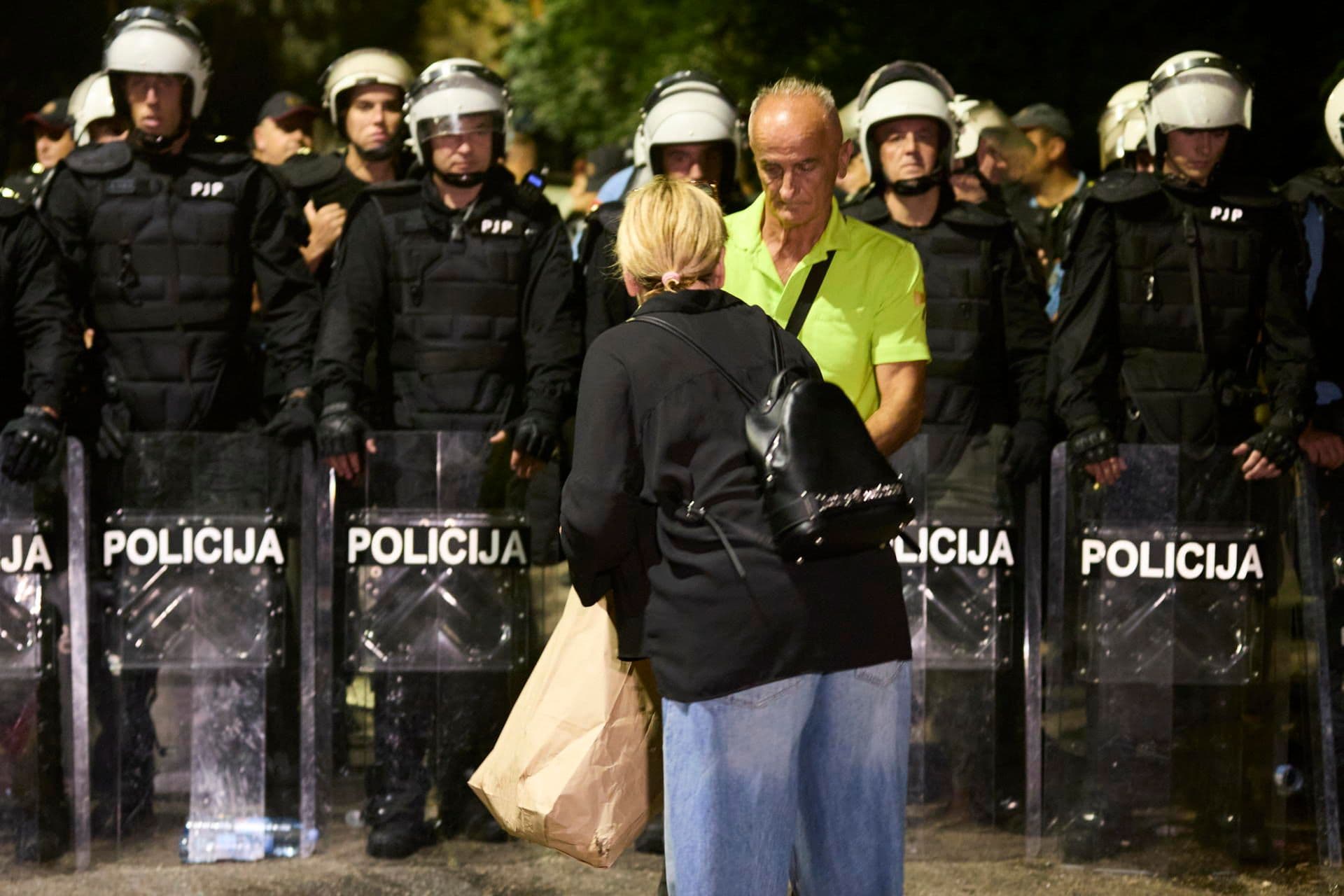Top Stories
Indiana Girl, 5, Seriously Injured in Pit Bull Attack Sparks Safety Debate

A five-year-old girl from Indiana is recovering from severe injuries after being attacked by two pit bulls in a friend’s backyard. The incident, which took place in South Bend, has left the young girl bloodied and permanently scarred.
Nylah Jones had just entered her friend’s backyard on S. Albert Avenue with her six-year-old brother when the dogs lunged at her without warning. The attack was brutal, with the animals sinking their teeth into her face and dragging her to the ground as she cried for help.
“I just heard my son yelling ‘Mom! Mom!'” recalled Jillquisha Jones, Nylah’s mother, in an interview with WNDU. “I was like, ‘What’s going on?’ and he said, ‘The dog is on Nylah!'”
Community Shock and Immediate Response
The horrifying incident unfolded around 7 p.m., drawing neighbors outside to the sound of screams. Angela, a neighbor, witnessed the aftermath, describing the scene as “nothing short of horrific.”
“She was bloody. She was being carried in blood-soaked arms toward the street,” Angela recounted. “She met her mom and was like, ‘We’ve got to go to the hospital.’ It was just a really crazy scene.”
Nylah was rushed to the emergency room with severe injuries, including dozens of deep cuts across her face. Doctors have warned that some of these scars may never heal completely.
“She has scars all over her face,” Jillquisha said. “They told me some of them might never go away.”
Emotional Impact and Family’s Frustration
The attack has left a lasting emotional imprint on Nylah’s brother, who witnessed the event and now struggles to talk about it. “Every time I look at her face, it just makes me really sad and cry,” he told 21Alive.
Nylah’s mother has expressed frustration with local authorities and animal control, who she claims have been unresponsive to her requests for answers or action. “At first, I just felt like they didn’t care,” Jillquisha said. “I’m calling them, I’m reaching out to animal control. Everybody from my friend’s list on my social media tried to reach out, and they’re not talking to me.”
Despite her injuries, Nylah has not lost her smile, though she remains fearful of going outside. Her mother emphasized the need for more urgency in handling such incidents. “There has to be more urgency. It shouldn’t take a little girl being torn up for someone to care.”
Official Response and Ongoing Investigation
The two pit bulls involved in the attack were voluntarily surrendered by their owners to the South Bend Animal Resource Center (SBARC). However, no charges have been filed, and the city has yet to confirm the consequences for the owners or whether the dogs will be euthanized.
The City of South Bend stated that all bite reports are reviewed “on a case-by-case basis,” considering the source of the report, the severity of the bite, and the circumstances surrounding the incident. SBARC officials have confirmed awareness of the incident but declined to comment on the ongoing investigation.
Broader Implications and Safety Concerns
This attack has reignited longstanding fears about safety around pit bulls, particularly concerning children. Animal rights groups and breed-specific advocates have long debated the temperament and risk posed by the breed. Critics point to fatal maulings, while defenders blame poor training or negligent owners.
The incident in South Bend underscores the need for a balanced discussion on animal safety and responsible ownership, as communities grapple with the implications of such attacks.
Top Stories
Adventurer Pilots 4,300 Miles Across Arctic in Helicopter

Jules Mountain, a 59-year-old entrepreneur and adventurer, recently completed an extraordinary journey piloting a Bell 505 helicopter over the Arctic, covering a staggering 4,300 miles from Canada to the UK. This remarkable feat, which took place in 2020, involved flying across some of the most inhospitable terrain on the planet, showcasing both his engineering acumen and daring spirit.
Mountain, who has a history of overcoming significant personal challenges, including a battle with cancer, embarked on what he now describes as his most dangerous venture yet. He chronicled this audacious journey in his memoir, titled Arctic Insanity: 4,300 miles over the polar ice cap by helicopter, set to be published on March 15, 2024.
From Idea to Execution
The helicopter journey began when a friend of Mountain’s purchased the Bell 505 with the intention of having it shipped back to the Channel Islands. Instead of opting for the conventional method, Mountain proposed an adventurous alternative: to fly it back himself. “I said, why not fly it back instead?” he recalled with a grin. This light aircraft, designed primarily for recreational use, was not intended for such an extensive trip across the Arctic.
Over the course of eight days, Mountain faced unforgiving conditions and logistical hurdles, including fuel limitations. To extend the helicopter’s range, he ingeniously rigged a flexible rubber fuel tank, which was strapped to the seat behind him. “We had to calculate when to start pumping,” he explained. “If the pump had failed, we would have been finished.”
High Stakes and Technical Challenges
The most perilous leg of the journey involved crossing from Canada to Greenland, where Mountain flew at an altitude of 14,000 feet to avoid ice formation on the helicopter’s blades. Despite the risks, he pushed through the challenges, demonstrating remarkable composure under pressure. “If something goes wrong, what are your options?” he said, emphasizing his focus on logic and preparation throughout the flight.
At times, he faced alarming situations, including an onboard alarm sounding at high altitude. “That was probably the most nerve-wracking bit,” he admitted. Yet, his determination and extensive preparation kept him focused, as he relied on both his engineering knowledge and the sustenance of his favorite candy, Wine Gums, to combat fatigue.
Mountain’s journey not only tested his flying skills but also revealed the resilience required to navigate the brutal Arctic environment. He encountered a series of near-misses with icebergs and dense fog, yet he remained undeterred. Upon finally landing in the UK, he celebrated a significant achievement: becoming the first person to fly a Bell 505 across the Atlantic and through Greenland and Iceland.
In recounting his experience, Mountain expressed a sense of renewed gratitude for life. “You are never more alive than when you are close to death,” he reflected, summing up the exhilaration of his adventure.
The memoir not only tells the story of his incredible journey but also aims to raise awareness for cancer charities, with proceeds going towards such causes. Mountain’s journey serves as a testament to his adventurous spirit and a reminder of the fragility of life.
Now residing in Guernsey with his family, Mountain continues to fly occasionally, often reflecting on the risks and rewards of his Arctic adventure. As he moves forward, he remains committed to embracing life fully, a philosophy shaped by his past experiences and triumphs over adversity.
Top Stories
Mastering Small Talk: Tips for Every Social Occasion

Navigating social interactions can be challenging, but understanding the nuances of small talk can enhance connections at various events—from first dates to weddings and even funerals. According to Gillian Sandstrom, an associate professor of psychology at the University of Sussex, initiating conversation often results in improved mood and a sense of connection, not just with the individual being spoken to, but with others as well.
Many people hold the misconception that small talk must remain superficial. In reality, conversations can be more engaging and meaningful. As society gears up for wedding season, mastering the art of small talk becomes increasingly important. Traditional guidelines suggest keeping topics light and steering clear of sensitive subjects like politics or religion, yet these can lead to mundane exchanges.
One effective strategy is to approach conversations with a clear purpose. Patrick King, a bestselling social interaction coach, emphasizes the importance of needing an answer. This mindset can transform conversation from a chore into an engaging experience. Tom Bouchier Hayes, a seasoned broadcast journalist, suggests that sharing something personal can encourage others to reciprocate, creating a more dynamic conversation.
When it comes to weddings, small talk can often feel forced or insipid. Guests frequently find themselves discussing the couple rather than engaging in meaningful dialogue. Bouchier Hayes advises steering clear of couples during these gatherings, as they may be less forthcoming with personal insights when their partner is present. Instead, starting with shared experiences related to the event, such as asking about the bride or groom, can pave the way for more interesting discussions.
Research indicates that deeper conversations tend to yield greater enjoyment. Sandstrom notes that people often underestimate their desire for substance in dialogue. For instance, asking about family backgrounds can lead to unexpected revelations, shifting the conversation from the mundane to the intriguing.
The “common third” concept, introduced by Yvalia Febrer, a professor of social work at Kingston University, highlights the power of shared experiences in fostering connection. Engaging in activities together can create a natural flow of conversation, breaking down social barriers and allowing for humor and camaraderie to develop.
In different contexts, such as professional settings or social gatherings, the approach to small talk must adapt. At business events, asking specific questions related to the conference or keynote address can demonstrate engagement and initiate productive dialogue. In more informal settings, such as parties, the key is to avoid probing into a partner’s past relationships, which can create discomfort.
Sandstrom’s research into conversations on public transport reveals that people often fear rejection when initiating dialogue. Yet, her study showed that rejection occurs only 13% of the time, suggesting that most individuals are open to connection. Those interactions can lead to surprisingly fulfilling exchanges, even in transient environments.
Navigating conversations at funerals can be particularly sensitive due to the diverse age range of attendees and the emotional weight of the occasion. Sandstrom’s studies indicate that cross-generational conversations often result in unexpected enjoyment and valuable insights. People generally appreciate the opportunity to share experiences and perspectives, reinforcing the idea that everyone seeks understanding and connection.
In conclusion, mastering small talk involves a blend of preparation, empathy, and adaptability. Whether at a wedding, corporate event, or casual gathering, the ability to foster genuine connections can significantly enhance social experiences. By focusing on shared interests and embracing the potential for deeper dialogue, individuals can transform small talk from a dreaded obligation into a rewarding aspect of social interaction.
Top Stories
Explore Costs and Choices for Private Jets from London to Dubai

Flying privately from London to Dubai offers an exclusive travel experience, but it comes at a significant cost. Chartering a private jet on this popular route typically ranges between $40,000 and $100,000 USD for a one-way flight. The price varies based on several factors, including the type of aircraft, time of year, and the level of luxury desired. This article delves into the costs, options, and considerations for those contemplating private air travel between these two major global hubs.
Understanding the Costs Involved
The cost of flying privately is not a fixed rate, unlike commercial airline tickets. On the lower end, light or midsize jets may be available, but most travelers opt for long-range heavy jets or ultra-long-range jets to enjoy nonstop service. For instance, chartering an ultra-long-range jet can cost up to $96,600 for a direct flight, as noted by evoJets. In contrast, JetFinder estimates a cost of around $40,000 for a super-midsize jet.
The route stretches approximately 3,400 nautical miles (about 6,300 kilometers), necessitating high fuel loads and longer crew duty hours, both of which significantly impact costs. In addition, round-trip flights can see costs increase by 1.7 to 2.2 times due to repositioning costs and airport availability.
Several factors influence the final price of a private jet flight. The type of aircraft is crucial; larger jets such as the Gulfstream G650 or Bombardier Global 7500 command higher prices due to their advanced range and luxury features. Flight duration also plays a role, with the London-Dubai journey typically taking between 6.5 to 7 hours. This extended flight time affects fuel consumption and en route charges imposed by air traffic authorities.
Key Factors That Affect Pricing
Dynamic pricing is a defining feature of private jet charters. The cost can fluctuate based on operational expenses, aircraft availability, and market demand. For instance, GlobeAir highlights how empty leg flights—flights that return to base without passengers—can offer significant savings, up to 50% off standard rates. However, these flights come with strict conditions, as travelers must adhere to fixed departure times and aircraft types.
Airport fees also contribute to overall costs. Busy private jet terminals, such as London Luton or Dubai Al Maktoum, impose higher landing and handling charges, particularly for those utilizing VIP services. Fuel prices further complicate the pricing structure, as they are subject to fluctuations in global oil markets, directly impacting operational expenses.
Additionally, crew costs must be factored in. When an aircraft and crew stay in Dubai awaiting the return leg, expenses for accommodation, per diem rates, and parking fees accumulate. If the plane needs to return to its base without passengers, those repositioning costs also reflect in the charter rates.
Industry experts emphasize three critical elements for this route: range, reliability, and service. According to evoJets, heavy jets are optimal for the London to Dubai journey, balancing cabin space with nonstop performance. Popular choices among charter providers include the following models:
– Bombardier Global 6000: Seats 14-17, range over 6,000 nm, priced between $85,000 and $95,000
– Gulfstream G650: Seats 14-18, range over 7,000 nm, priced between $90,000 and $100,000
– Dassault Falcon 7X: Seats 12-16, range of 5,950 nm, priced between $75,000 and $85,000
– Embraer Legacy 600: Seats 10-13, range of 3,400 nm, priced between $65,000 and $75,000
– Bombardier Challenger 850: Seats 12-15, range of 2,800 nm, priced between $60,000 and $70,000
Choosing the right aircraft is essential for ensuring a seamless journey, particularly when considering comfort and baggage allowances.
When set against commercial airline options, private jet costs seem steep. First-class tickets on airlines like Emirates or British Airways typically range from $3,000 to $6,000 for a one-way trip, while business class can drop to around $1,800 during promotional periods. Yet, private jets provide unique benefits beyond what commercial flights offer.
Private aviation allows travelers to use exclusive terminals, bypassing the crowded commercial airports, and often enables arrival just minutes before departure. Furthermore, passengers enjoy ultimate control over their schedules, with flights tailored to their preferences rather than fixed timetables. This flexibility is particularly valuable for business travelers under tight deadlines.
Moreover, private aviation enhances the travel experience with minimal wait times at security and boarding. Check-in is streamlined through private lounges, significantly reducing stress.
In-flight customization adds another layer of appeal, allowing adjustments to catering, cabin lighting, and entertainment options to suit individual tastes. The high level of privacy afforded by private jets is ideal for high-profile travelers or those handling sensitive discussions.
For groups, private flights can become more cost-effective. Splitting a $70,000 flight among ten passengers results in a per-person cost of $7,000, comparable to premium commercial cabin pricing.
Considerations and Limitations
Despite the advantages, there are limitations to private travel that clients should understand. Weather-related diversions can affect smaller jets more, leading to potential delays. Additionally, geopolitical tensions may influence flight paths, causing longer routes and increased costs.
Empty leg flights, while potentially cheaper, carry risks of instability and reduced flexibility. Clients must be prepared for the possibility of last-minute changes that could disrupt travel plans.
Aircraft availability can also be an issue during peak times, such as holidays or major events, leading to inflated prices or limited options. Working with reputable charter providers is crucial to mitigate these risks and ensure smooth travel arrangements.
In conclusion, chartering a private jet from London to Dubai represents a premium travel option that offers unparalleled flexibility, comfort, and privacy. With costs ranging from $40,000 to over $100,000, this service is a significant investment. Yet, for many travelers—be they business professionals, diplomats, or individuals seeking discretion—the benefits can outweigh the expenses. As the market evolves, more competitive pricing and increased availability may enhance the appeal of private aviation, especially for those traveling between these two vibrant cities.
Top Stories
Podgorica Protest Highlights Tension Over Literary Award Decision

A protest organized by the informal civic association STEGA took place in Podgorica, Montenegro, on Thursday evening, drawing attention to the controversial awarding of the Trinaestojulska nagrada to writer Bećir Vuković. The demonstration concluded around 10 PM, with police preventing participants from reaching Vila Gorica, where Andrija Mandić, the President of the Parliament, presented the awards to this year’s laureates.
The protest, captured through the lens of Pobjeda’s photojournalist Stevo Vasiljević, showcased the public’s discontent with the decision to honor Vuković, a figure whose literary contributions have sparked debate within the cultural community. The images provide a vivid depiction of the evening’s events, highlighting the tension between the authorities and the demonstrators.
Background on the Controversy
The Trinaestojulska nagrada, one of Montenegro’s most prestigious awards, is traditionally given to individuals who have made significant contributions to the country’s cultural and social landscape. This year’s choice of Vuković has been met with criticism from various quarters, with detractors questioning the criteria and motivations behind the selection.
Vuković, known for his provocative writing style, has often been a polarizing figure. His supporters argue that his work challenges societal norms and encourages critical discourse, while critics claim it sometimes crosses the line into divisiveness.
Public Response and Demonstrations
The protest organized by STEGA is part of a broader public response to the award decision. Participants expressed their dissatisfaction not only with the choice of laureate but also with what they perceive as a lack of transparency in the award process.
According to sources close to the organizers, the protest aimed to send a clear message to the authorities about the need for greater accountability and inclusivity in cultural recognitions. The presence of law enforcement and their decision to block access to Vila Gorica underscored the tensions surrounding the event.
Expert Opinions and Historical Parallels
Experts in Montenegrin culture and politics have weighed in on the controversy, noting that it reflects broader societal divisions. Dr. Milena Jovanović, a cultural historian, commented, “This situation is emblematic of the ongoing struggle between traditional values and modern, progressive ideals in Montenegro.”
Historically, the Trinaestojulska nagrada has been a barometer of the country’s cultural climate. In the past, award decisions have sparked similar debates, often serving as a catalyst for discussions about national identity and values.
“The Trinaestojulska nagrada has always been more than just an award; it’s a reflection of where Montenegro stands as a society,” Dr. Jovanović added.
Looking Ahead
The protest and the surrounding controversy are likely to have lasting implications for Montenegro’s cultural landscape. The government and cultural institutions may face increased pressure to reevaluate the criteria and processes for such prestigious awards.
Meanwhile, the images captured by Stevo Vasiljević will continue to resonate with those who participated in the protest and those who watched from afar, serving as a powerful reminder of the ongoing dialogue about culture and recognition in Montenegro.
As the country grapples with these issues, the conversation around the Trinaestojulska nagrada and its recipients will undoubtedly continue, shaping the future of Montenegrin culture and its place in the broader European context.
-

 Health4 days ago
Health4 days agoCrime Documentaries Gain Popularity Amid Summer Sports Frenzy
-

 Business4 days ago
Business4 days agoUK Couples Can Boost Tax-Free Allowance to £13,830 with Marriage Allowance
-

 Technology4 days ago
Technology4 days agoXbox Shelves Highly Anticipated Sci-Fi Game Blackbird Despite Praise
-

 Sports4 days ago
Sports4 days agoShane van Gisbergen’s Dominant Qualifying Run Sets Stage in Chicago
-

 Education12 hours ago
Education12 hours agoInside the Life of Nico Hülkenberg: Meet Eglė Ruškytė and Daughter Noemi
-

 Education14 hours ago
Education14 hours agoYasmin Broom: From X Factor Stardom to Love Island Fame
-

 Entertainment6 days ago
Entertainment6 days agoSlipknot’s Mysterious Countdown Sparks Speculation of Album Reissue
-

 Education4 days ago
Education4 days agoWigan School-Leavers Celebrate with Glamorous Prom Photos
-

 Business11 hours ago
Business11 hours agoGemma Collins’ Weight-Loss Drug Ad Banned by UK Regulator

